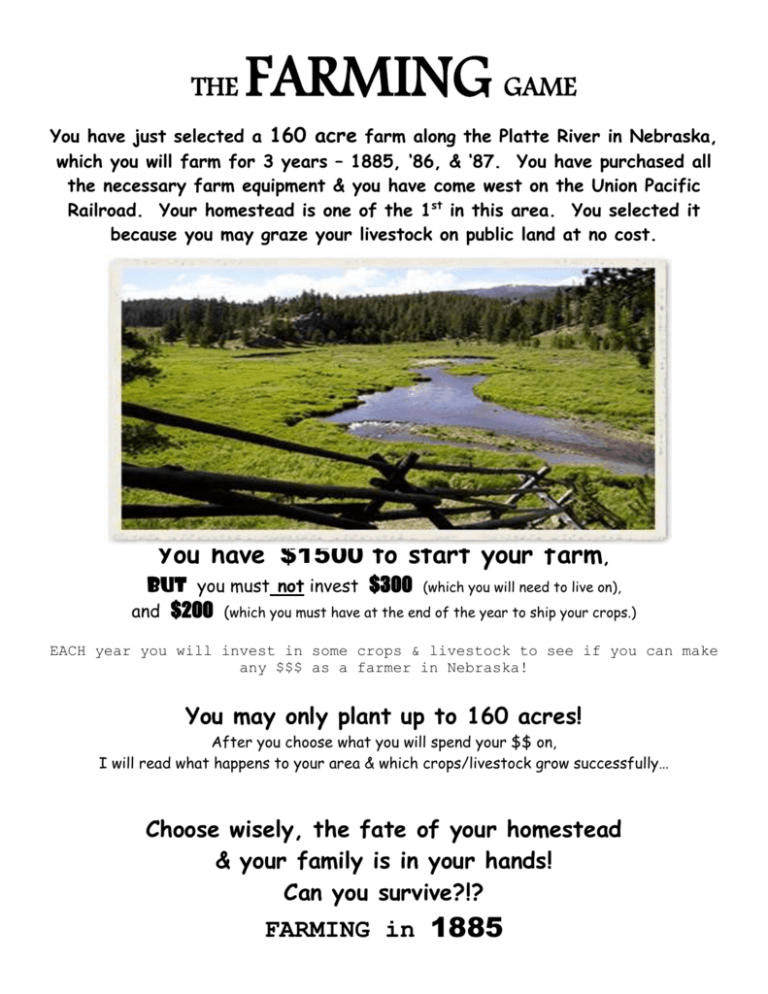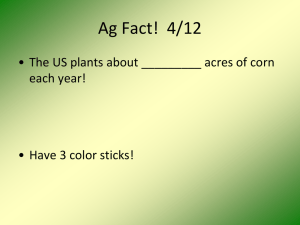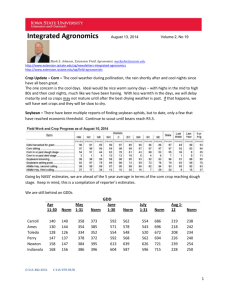FARMING GAME - Dunkfordhistory
advertisement

THE FARMING GAME You have just selected a 160 acre farm along the Platte River in Nebraska, which you will farm for 3 years – 1885, ‘86, & ‘87. You have purchased all the necessary farm equipment & you have come west on the Union Pacific Railroad. Your homestead is one of the 1st in this area. You selected it because you may graze your livestock on public land at no cost. You have $1500 to start your farm, but you must not invest $300 (which you will need to live on), and $200 (which you must have at the end of the year to ship your crops.) EACH year you will invest in some crops & livestock to see if you can make any $$$ as a farmer in Nebraska! You may only plant up to 160 acres! After you choose what you will spend your $$ on, I will read what happens to your area & which crops/livestock grow successfully… Choose wisely, the fate of your homestead & your family is in your hands! Can you survive?!? FARMING in 1885 Scoring Sheet DIRECTIONS: 1. Your living expenses are $300 a year & your costs to ship by RR are $200 per year. 2. You may plant only 160 acres in crops on your homestead. You may plant on rented land at $100 for 50 acres. Rented land must be in 50 acre units. 3. You must plant crops in 10 acre units. STARTING CAPITAL FOR THE YEAR 188__ IS (A) $ ________ Subtract the Following From line (A) Cost of Living (B1) $ 300 Cost of Transportation – RR (B2) $ 200 Final AMOUNT Available for use on Farm this year: (C)$_________ (Line A minus Line B1 and B2) CROPS # of Acres Income Planted Corn ________ Cost Per Total Cost Acre What’s it of Crop Worth? $5 _________ __________ $5 _________ __________ $2 _________ __________ $2 _________ __________ $2 _________ __________ $1 _________ __________ $10 _________ __________ ________ Beans ________ ________ Wheat ________ ________ Barley ________ ________ Oats ________ ________ Field hay ________ ________ Tobacco ________ ________ Field peas ________ $5 _________ __________ ________ Rented Land _______ $100 for _________ _____0____ ____0___ 50 acres LIVESTOCK Number of Income Animals Cost per Total Cost Animal of Animals Investment Return Cattle _________ $10 __________ ___________ ________ Sheep _________ $5 __________ ___________ $5 __________ ___________ ________ Hogs _________ ________ Savings __________ _____1____ ________ Total Amount spent for the year (including savings if any - Total must match line (C) $________ Total Income for 1885 $ _____________________ * this is your starting amount (A) for 1886 FARMING in ‘86 Scoring Sheet DIRECTIONS: 1. You may plant only 160 acres in crops on your homestead. You may plant on rented land at $100 for 50 acres. Rented land must be in 50 acre units. 2. You must plant crops in 10 acre units. STARTING CAPITAL FOR THE YEAR 1886 IS (A) $ ________ Subtract the Following From line (A) Cost of Living (B1) $ 300 Cost of Transportation – RR (B2) $ 400 Final AMOUNT Available for use on Farm this year: (C)$_________ (Line A minus Line B1 and B2) CROPS # of Acres Income Planted Corn ________ Cost Per Acre Total Cost of Crop Investment Return $5 _________ __________ $5 _________ __________ $2 _________ __________ $2 _________ __________ $2 _________ __________ ________ Beans ________ ________ Wheat ________ ________ Barley ________ ________ Oats ________ ________ Field hay ________ $1 _________ __________ $10 _________ __________ ________ Tobacco ________ ________ Field peas ________ $5 _________ __________ ________ Rented Land _______ $100 for _________ _____0____ ____0___ 50 acres LIVESTOCK Number of Cost per Total Cost Investment Income Animals Animal of Animals Return Cattle _________ $10 __________ ___________ ________ Sheep _________ $5 __________ ___________ $5 __________ ___________ ________ Hogs _________ ________ Savings __________ _____1____ ________ Total Amount spent for the year (including savings if any - Total must match line (C) $________ Total Income for ‘86 $ _____________________ FARMING in ‘87 Scoring Sheet DIRECTIONS: 1. You may plant only 160 acres in crops on your homestead. You may plant on rented land at $100 for 50 acres. Rented land must be in 50 acre units. 2. You must plant crops in 10 acre units. STARTING CAPITAL FOR THE YEAR 1887 IS (A) $ ________ Subtract the Following From line (A) Cost of Living (B1) $ 300 Cost of Transportation – RR (B2) $ 600 Final AMOUNT Available for use on Farm this year: (C)$_________ (Line A minus Line B1 and B2) CROPS # of Acres Income Cost Per Total Cost Investment Planted Corn ________ Acre of Crop Return $5 _________ __________ $5 _________ __________ $2 _________ __________ $2 _________ __________ $2 _________ __________ $1 _________ __________ $10 _________ __________ ________ Beans ________ ________ Wheat ________ ________ Barley ________ ________ Oats ________ ________ Field hay ________ ________ Tobacco ________ ________ Field peas ________ $5 _________ __________ ________ Rented Land _______ $100 for _________ _____0____ ____0___ 50 acres LIVESTOCK Number of Cost per Total Cost Investment Income Animals Animal of Animals Return Cattle _________ $10 __________ ___________ ________ Sheep _________ $5 __________ ___________ $5 __________ ___________ ________ Hogs _________ ________ Savings __________ _____1____ ________ Total Amount spent for the year (including savings if any - Total must match line (C) $________ Total Income for ‘87 $ _____________________ 1885 A serious lack of early spring rain followed by too much rain in July almost destroyed the wheat, barley, and oat crop in central Nebraska. The Prices paid for corn, beans, field peas, and tobacco are up because of drought east of the Mississippi. Cattle prices are depressed because of large herds of range stock being sold in Texas. The price for sheep is up and the price paid for hogs is at an all time high. CROP INVESTMENT RETURN (MULTIPLY BY) Corn 2 3 1 1 1 2 2 2 1 2 3 Beans Wheat Barley Oats Field Hay Tobacco Field Peas Cattle Sheep Hogs ’86 The coldest winter in history with temperatures 60 below zero destroyed most of the sheep and hogs. Cattle prices are high Abundant spring and summer rain through out most of the state has produced excellent crops. The price of corn, wheat, barley, and oats is good. The prices of tobacco & field peas remains the same. The bean crop has produced a small yield because of late frost. The field hay prices are depressed because of limited demand for hay. CROP Corn Beans Wheat Barley Oats Field hay Tobacco Field peas Cattle Sheep Hogs INVESTMENT RETURN (MULTIPLY BY) 2 1 2 2 2 1 2 2 3 0 0 ’87 Nature deals a crushing blow to farmers in Nebraska. After a hot dry spring with little rain, a plague of grasshoppers infested the crops. Most crops are badly damaged. Cattle prices are very good, as the range herds have not yet recovered from the killing winter of ’86. Sheep prices are depressed by Hog prices are good. CROP INVESTMENT RETURN (MULTIPLY BY) Corn Beans Wheat Barley Oats Field hay Tobacco Field peas Cattle Sheep Hogs 1 1.5 2 1.5 1 2 1 1 3 1 2 NOW, INVEST THE REST! You now have $1000 to invest in crops or livestock. Write that on line (A) on your scoring sheet for 1885. You may only spend this amount when choosing your crops for the year. Listed on the scoring sheet is the cost-per-acre for each crop. You may also spend some of your money for livestock. The scoring sheet lists the price per animal. Animals may be grazed on public land at no cost (you don’t have to have acres for them!). All costs, such as seed, labor, supplies, taxes and maintenance are included in your cost per acre, or per animal. *If you wish to farm more than 160 acres, you may rent it from the government at $100 for each 50 acre block. FILL OUT YOUR SCORE SHEET… Look at the sheet entitled “Farming 1885-1887.” 1. On the line at the top fill in $1000 as your capital & the year 1885. 2. Select which crop or crops you wish to plant. EX: If you plant 160 acres of corn and use all your land, the cost will be 160 x $5 = $800. You will have $200 left to invest in livestock. If you select cattle and spend your remaining $200, you may purchase 20 cows (20 cows x $10 = $200) 3. After you have selected what you will grow, use the square on the scoring sheet & divide your land & label the various crops. FIGURING YOUR PROFIT: When everyone in class has spent their capital, I will read what happens to your crops & your “investment return” (the amount which you multiply times the amount you invested in a crop) EX: If you spent $800 on corn and the Investment Return for 1885 was 2, you would multiply $800 x 2. $1600 would be your profit on corn. If you had invested $200 in cattle and the 1885 Investment Return for cattle was 1, you would multiply 1 x $200. This would be your profit on the cattle. When you have calculated your profits, total them. This becomes your capital for the year 1886. In the earlier example, the total profits made for 1885 for raising corn and cattle (corn $1600 and cattle $200) were $1800. Using your total profits from 1885, allocate your money






